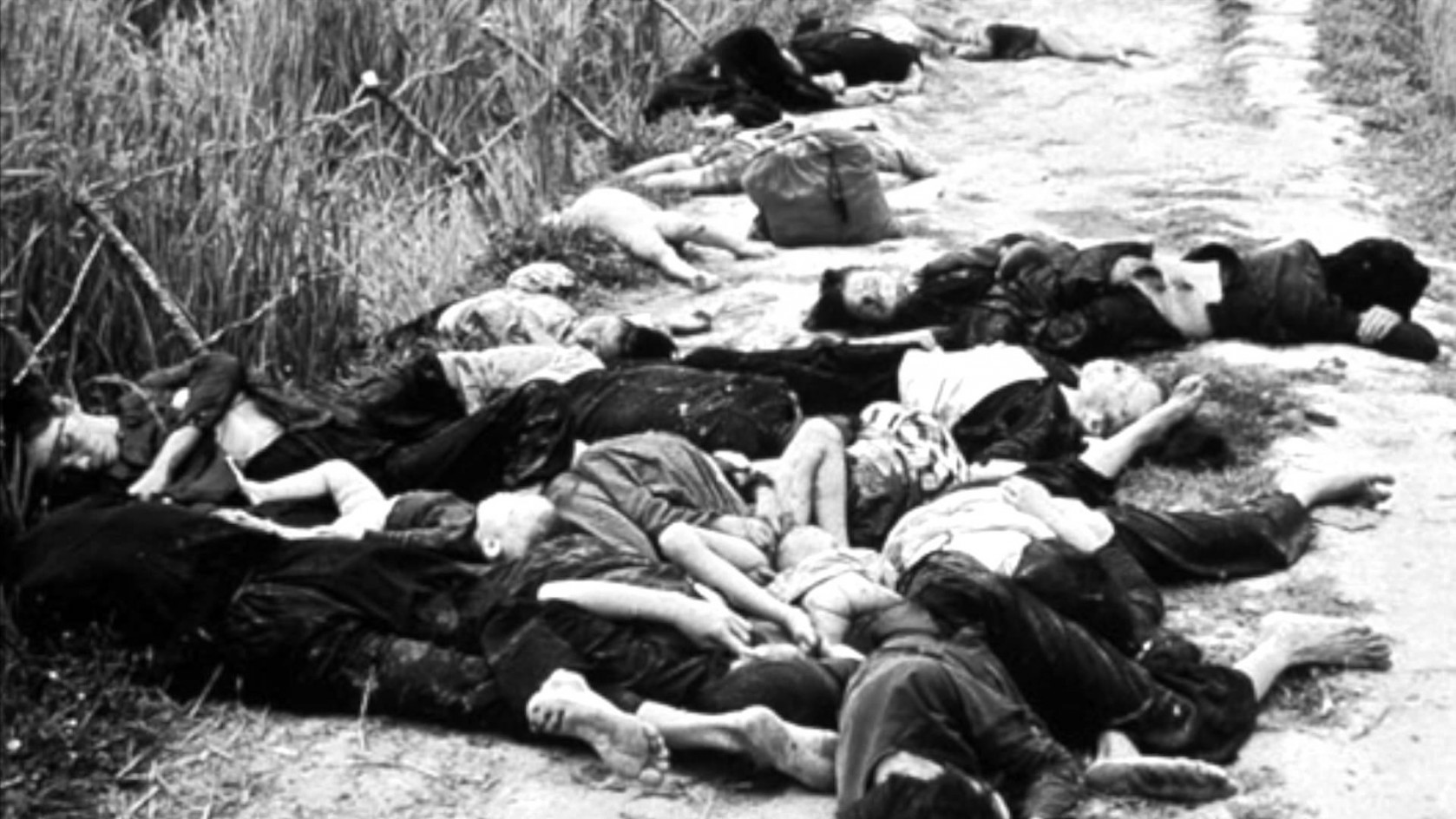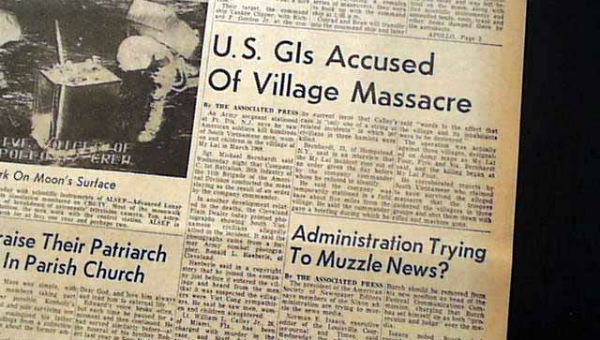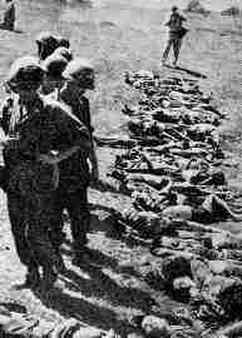


The Mỹ Lai massacre (/ˌmiːˈlaɪ/; Vietnamese: Thảm sát Mỹ Lai [tʰâːm ʂǎːt mǐˀ lāːj] ( listen)) was the mass murder of unarmed South Vietnamese civilians by United States troops in Sơn Tịnh District, South Vietnam, on 16 March 1968 during the Vietnam War. Between 347 and 504 unarmed people were killed by U.S. Army soldiers from Company C, 1st Battalion, 20th Infantry Regiment, and Company B, 4th Battalion, 3rd Infantry Regiment, 11th Brigade, 23rd (Americal) Infantry Division. Victims included men, women, children, and infants. Some of the women were gang-raped and their bodies mutilated and were as young as 12. Twenty-six soldiers were charged with criminal offenses, but only Lieutenant William Calley Jr., a platoon leader in C Company, was convicted. Found guilty of murdering 22 villagers, he was originally given a life sentence but served three-and-a-half years under house arrest after President Richard Nixon commuted his sentence.
listen)) was the mass murder of unarmed South Vietnamese civilians by United States troops in Sơn Tịnh District, South Vietnam, on 16 March 1968 during the Vietnam War. Between 347 and 504 unarmed people were killed by U.S. Army soldiers from Company C, 1st Battalion, 20th Infantry Regiment, and Company B, 4th Battalion, 3rd Infantry Regiment, 11th Brigade, 23rd (Americal) Infantry Division. Victims included men, women, children, and infants. Some of the women were gang-raped and their bodies mutilated and were as young as 12. Twenty-six soldiers were charged with criminal offenses, but only Lieutenant William Calley Jr., a platoon leader in C Company, was convicted. Found guilty of murdering 22 villagers, he was originally given a life sentence but served three-and-a-half years under house arrest after President Richard Nixon commuted his sentence.
This war crime, which was later called "the most shocking episode of the Vietnam War", took place in two hamlets of Sơn Mỹ village in Quảng Ngãi Province. These hamlets were marked on the U.S. Army topographic maps as Mỹ Lai and Mỹ Khê.
The U.S. Army slang name for the hamlets and sub-hamlets in that area was Pinkville, and the carnage was initially referred to as the Pinkville Massacre. Later, when the U.S. Army started its investigation, the media changed it to the Massacre at Songmy. Currently, the event is referred to as the Mỹ Lai Massacre in the United States and is called the Sơn Mỹ Massacre in Vietnam.
The incident prompted global outrage when it became public knowledge in November 1969. The incident contributed[11] to domestic opposition to the U.S. involvement in the Vietnam War, both because of the scope of killing and cover-up attempts.
Initially, three U.S. servicemen who had tried to halt the massacre and rescue the hiding civilians were shunned and even denounced as traitors by several U.S. Congressmen, including Mendel Rivers (D–South Carolina), Chairman of the House Armed Services Committee. Thirty years later, these servicemen were recognized and decorated, one posthumously, by the U.S. Army for shielding non-combatants from harm in a war zone.
Along with the No Gun Ri massacre in South Korea 18 years earlier, Mỹ Lai was one of the largest publicized massacres of civilians by U.S. forces in the 20th century. Wikipedia
Below is a list of the men who took part in the My Lai Massacre and their charges.
- Lieutenant Colonel Frank A. Barker – commander of the Task Force BARKER, a battalion-sized unit, assembled to attack the 48th Battalion of the Viet Cong supposedly based in and around My Lai. He allegedly ordered the destruction of the village and supervised the artillery barrage and combat assault from his helicopter. Reported the operation as a success; was killed in Vietnam on June 13, 1968, in a mid-air collision before the investigation had begun.
- Captain Kenneth W. Boatman - an artillery forward observer; was accused by the Army of failure to report possible misconduct, but the charge was dropped.
- Second Lieutenant Stephen Brooks – the 2nd Platoon Leader, Charlie Company; turned a body count of 60 for the second platoon; later killed himself in Vietnam.
- Major Charles C. Calhoun - operations officer of Task Force BARKER; charges against him of failure to report possible misconduct were dropped.
- Second Lieutenant William L. Calley Jr. – platoon leader, 1st Platoon, Charlie Company, First Battalion, 20th Infantry Regiment, 11th Infantry Brigade, 23rd Infantry Division. Was charged in the deliberate murder of 102 civilians, found guilty, and sentenced to life. Was paroled in September 1974 by the Secretary of the Army Howard Callaway.
- Lieutenant Colonel William D. Guinn Jr. - Deputy Province Senior Advisor/Senior Sector Advisor for Quangngai Province. Charges against him of dereliction of duty and false swearing brought by the Army were dropped.
- Colonel Oran K. Henderson – 11th Infantry Brigade commander, ordered the attack and flew in a helicopter over Mỹ Lai during it. After Hugh Thompson immediately reported multiple killings of civilians, Henderson started the cover-up by dismissing allegations about the massacre and reporting to the superiors that indeed 20 people from My Lai died by accident. Was accused of the alleged cover-up and false swearing by the Army; charges were dropped.
- Major General Samuel W. Koster – commander of the 23rd Infantry Division (United States) of the United States Army, known as the AMERICAL Division, was not involved with the planning of the My Lai search-and-destroy mission. However, during the operation, he flew over My Lai and monitored the radio communications. Afterward, Koster did not follow up with the 11th Brigade commander colonel Henderson on the initial investigation and later was caught in a cover-up. Was charged by the Army with failure to obey lawful regulations, dereliction of duty, and alleged cover-up; charges were dropped. Later was demoted to Brigadier General and stripped of a Distinguished Service medal.
- Captain Eugene M. Kotouc – military intelligence officer assigned to Task Force BARKER; he partially provided information, on which the Mỹ Lai combat assault was approved; together with Medina and a South Vietnamese officer, he interrogated, tortured, and allegedly executed VC and NVA suspects later that day. Was charged with maiming and assault, tried by the jury, and acquitted.
- Captain Dennis H. Johnson - 52d Military Intelligence Detachment, assigned to Task Force BARKER, was accused of failure to obey lawful regulations, however, charges were later dropped.
- Second Lieutenant Jeffrey U. Lacross - platoon leader, 3rd Platoon, Charlie Company; testified that his platoon did not meet any armed resistance in My Lai and that his men did not kill anybody, however, since, in his words, both Calley and Brooks reported a body count of 60 for their platoons, he then submitted a body count of 6.
- Major Robert W. McKnight - operations officer of the 11th Brigade; was accused of false swearing by the Army, but charges were subsequently dropped.
- Captain Ernest L. Medina – commander of Company C, First Battalion, 20th Infantry; nicknamed Mad Dog by subordinates. He planned, ordered, and supervised the execution of the operation in Son My village. Was accused of failure to report a felony and of murder; went to trial and was acquitted.
- Captain Earl Michaels - company commander during My Lai operation; he died in a helicopter crash three months later.
- Brigadier General George H. Young Jr. - assistant division commander, 23rd Infantry Division; charged with the alleged cover-up, failure to obey lawful regulations, and dereliction of duty by the Army; charges were dismissed.
- Major Frederic W. Watke - commander of Company B, 123rd Aviation Battalion, 23rd Infantry Division, providing helicopter support on March 16, 1968. Testified that he informed Colonel Henderson about killings of civilians in My Lai as reported by helicopter pilots. He was accused of failure to obey lawful regulations and dereliction of duty; charges were dropped.
- Captain Thomas K. Willingham - Company B, Fourth Battalion, Third Infantry Division, assigned to Task Force BARKER; charged with making false official statements and failure to report a felony; charges were dropped.
Altogether, 14 officers, directly and indirectly, involved with the operation, including two generals, were investigated in connection with the My Lai massacre, except Lieutenant Colonel Frank A. Barker, Captain Earl Michaels, and Lieutenant Stephen Brooks, who had died before the beginning of the investigation.The My Lai Massacre 1968



![]() listen)) was the mass murder of unarmed South Vietnamese civilians by United States troops in Sơn Tịnh District, South Vietnam, on 16 March 1968 during the Vietnam War. Between 347 and 504 unarmed people were killed by U.S. Army soldiers from Company C, 1st Battalion, 20th Infantry Regiment, and Company B, 4th Battalion, 3rd Infantry Regiment, 11th Brigade, 23rd (Americal) Infantry Division. Victims included men, women, children, and infants. Some of the women were gang-raped and their bodies mutilated and were as young as 12. Twenty-six soldiers were charged with criminal offenses, but only Lieutenant William Calley Jr., a platoon leader in C Company, was convicted. Found guilty of murdering 22 villagers, he was originally given a life sentence but served three-and-a-half years under house arrest after President Richard Nixon commuted his sentence.
listen)) was the mass murder of unarmed South Vietnamese civilians by United States troops in Sơn Tịnh District, South Vietnam, on 16 March 1968 during the Vietnam War. Between 347 and 504 unarmed people were killed by U.S. Army soldiers from Company C, 1st Battalion, 20th Infantry Regiment, and Company B, 4th Battalion, 3rd Infantry Regiment, 11th Brigade, 23rd (Americal) Infantry Division. Victims included men, women, children, and infants. Some of the women were gang-raped and their bodies mutilated and were as young as 12. Twenty-six soldiers were charged with criminal offenses, but only Lieutenant William Calley Jr., a platoon leader in C Company, was convicted. Found guilty of murdering 22 villagers, he was originally given a life sentence but served three-and-a-half years under house arrest after President Richard Nixon commuted his sentence. Individual and collective responsibility : massacre at My Lai
by
French, Peter A.
Individual and collective responsibility : massacre at My Lai
by
French, Peter A.
 Boca Raton General Collection DS557.A67 G47
by
Gershen, Martin.
Boca Raton General Collection DS557.A67 G47
by
Gershen, Martin.
